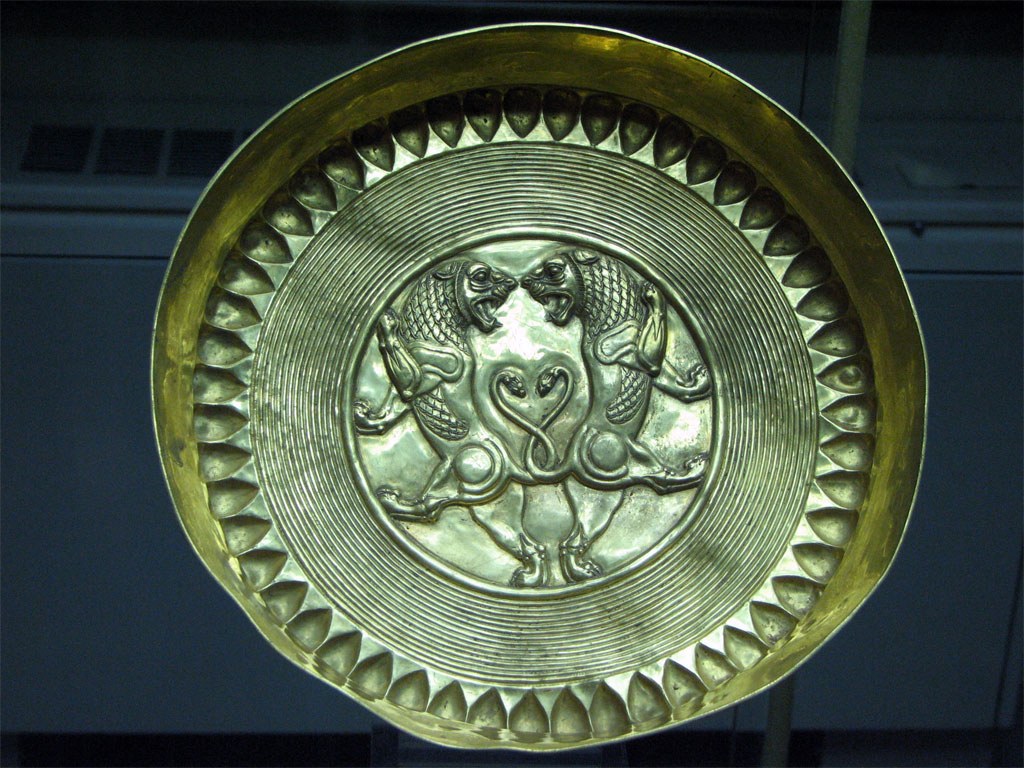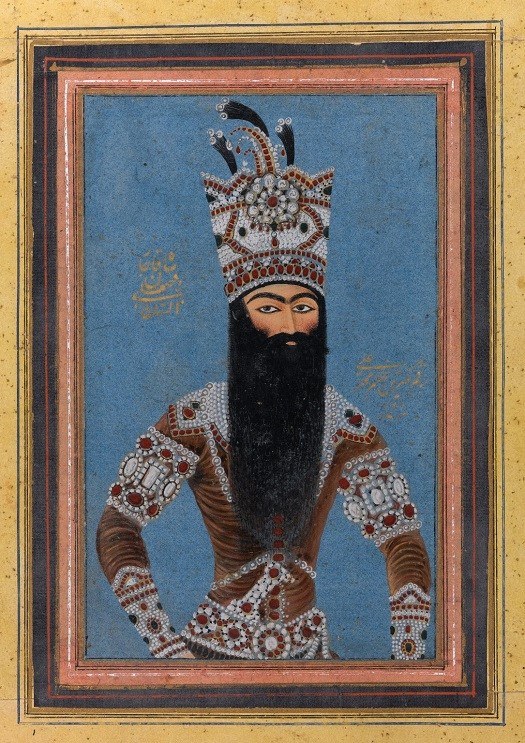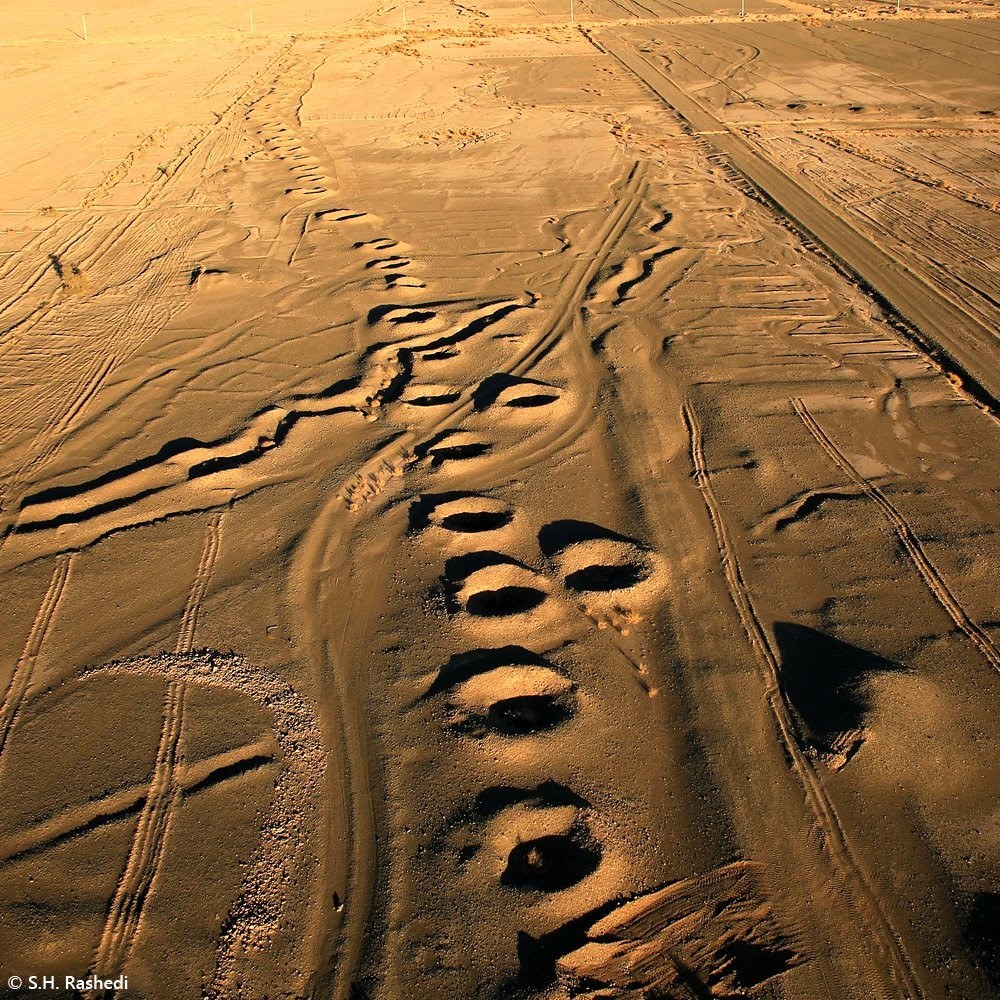
The Persian Qanat or Kariz (aqueduct) is an ancient water distribution system, which has been registered as a tangible Iranian cultural heritage on the UNESCO World Heritage List. Iranians were the first inventors of the aqueduct, But this method was later introduced to other countries from China to Morocco and America. The invention of the aqueduct can be described as the most significant contribution of Iranians in the field of water supply. This system can be traced back to at least 5 thousand years ago in Iran. The Kariz system is mostly found in the arid central regions, towards the east and southeast of Iran.
Some ancient Persian Qanat water supply systems in Iran are:
- The ancient Zavareh aqueduct, which some researchers believe dates back to 5 thousand years ago
- Gonabad aqueduct with a depth of 350 meters dating back 2500 years, is the deepest aqueduct in Iran
- The 40-kilometer aqueduct of the Tchogha Zanbil water treatment facility, which dates back to at least 3250 years ago
- The thousand-year-old water distribution network of Milan village, is located in east Azerbaijan province.
Since ancient times, the supply and salvage of water for drinking, irrigation, washing, etc., has been a vital factor in survival. That is why all the aqueducts, water reservoirs, yakhchāl (ice pit), water mills, water dams, bridges, and diversion dams were built.
Aqueduct building is the establishing facilities with the same percussive drilling method used to build mines, in which canals or waterways were used to extract water from groundwater reserves and transport it to the surface. The water would be transported from the mother well (where the water flows) into the aqueduct and to the surface outlet or the irrigation channel with the help of the earth’s gravity. The water transport route was a tunnel with a gentle slope.
Origin and Spread of Qanat
The earliest examples of underground water distribution systems were built in ancient Iran. The exact origin of the Qanat system cannot be determined, but according to historical evidence, they were developed in Ancient Iran over 5,000 years ago. Some sources believe that Qanats were originally invented in Southeast Arabia.
Most historical evidence suggests that ancient Persians invented the Qanat system in the first millennium BCE, or most accurately in 700 BCE. This is supported by the Zarch Qanat in Yazd and the Ghasabeh Qanats in Razavi Khorasan Province, an example of Achaemenid architecture. Some sources suggest the first Iranian Qanats were constructed 5-6,000 years ago, such as the Zavareh Qanat in Ardestan, Isfahan Province. A series of 14 aqueducts in Zaraveh are still operational after five thousand years.
Aqueducts in Other Ancient Civilizations
There are records of similar systems that were developed by other civilizations across the world. However, it should be noted that while aqueducts share similar features with the Qanat, the main difference is the source of water. Qanats exploit underground water reserves, while aqueducts reroute the water current from lakes, rivers, and dams.
In China, the first examples of aqueducts date back to 600 BCE, developed for farm irrigation. In the Roman Empire, the Aqua Appia aqueduct was constructed in 312 BCE by Appius Claudius Caecus. The Nazca created their water irrigation system between 300-500 CE called puquios, a series of subterranean water canals used to transport water.
There is little information to prove or disprove whether these systems were inspired by the Persian Qanat, or if they were independent inventions. Some aqueducts, such as the Roman Aqua Appia, used similar hydraulic techniques to transport water over hills. Given the cultural exchange between the Roman and Persian empires and the construction date of the Aqua Appia, it can be assumed that the Romans were inspired by the inventions of their Iranian counterparts.
Achaemenid Expansion and the Spread of Qanats
With the rise of the Achaemenid empire, they created more Qanats in their territories. Other kingdoms in modern Turkey, Iraq, and Arabia adopted their water distribution technology as a result of cultural exchange. The invention signifies ancient knowledge and a basic understanding of hydraulics.
Qanat systems were developed to access and redirect underground water reserves to villages and farms. There is a theory that suggests Qanats were first invented to irrigate cotton farms. Cotton was exported from India, which was substantially more humid. To cultivate cotton in the arid areas of Irans, ancient Persians created this system to double their irrigation rates. The resulting expansion in farmlands led to an abundance of resources that were influential in the rise of the Persian Empires, especially the Achaemenid.
By 400 BCE, Persian architects figured out how to use Qanats to prolong food storage capacities. They created the Yakhchal (ice pit) that was cooled down by the flow of cold water in the Qanat. In the winter, this ice pit was used to freeze water more efficiently. In the summer, the covered construct would prevent the ice from melting quickly. The ice pits were used to store perishable foods in the summer as well.
Qanat in Other Cultures
In the Islamic period, this invention was exported to Muslim territories in North Africa, Southern Europe, and South Asia. Each region exhibits a unique adaptation of the original aqueduct system according to regionally-specific geological conditions.
The original word for Qanat in ancient Persia was Kahan. The word Qanat has an Arabic origin and became common in the Islamic Period. There are various words for the Qanat in Middle Eastern and African regions, including:
- Kariz (Karez), Kahan in Iran, Afghanistan, and Pakistan
- Falaj in Oman and UAE
- Foggara in North Africa
- Khettara in Morroco
- Uyun in Saudi Arabia
- Galerías, Minas or viajes de agua in Spain
List of Famous Qanats in Iran
The UNESCO World Heritage Centre has inscribed 11 Persian Qanats in Iran as World Heritage Sites:
Ghasabe Qanat of Gonabad
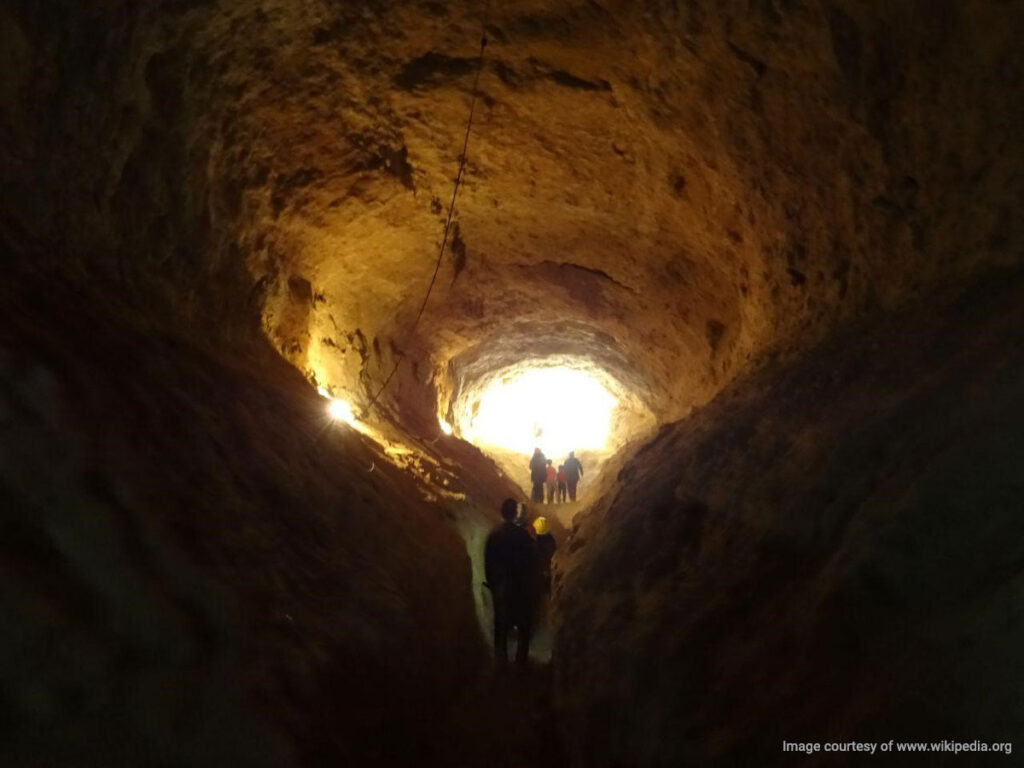
- Location: Gonabad, Razavi Khorasan Province, Iran
- History: Constructed over 2,500 years ago during the Achaemenid Empire.
- Structure: Consists of 427 wells with a total length of approximately 33 kilometers.
- Function: Provides water for agriculture and daily use, sustaining nearly 40,000 people.
- UNESCO Status: Inscribed as a UNESCO World Heritage Site in 2016.
Qanats of Baladeh Ferdows
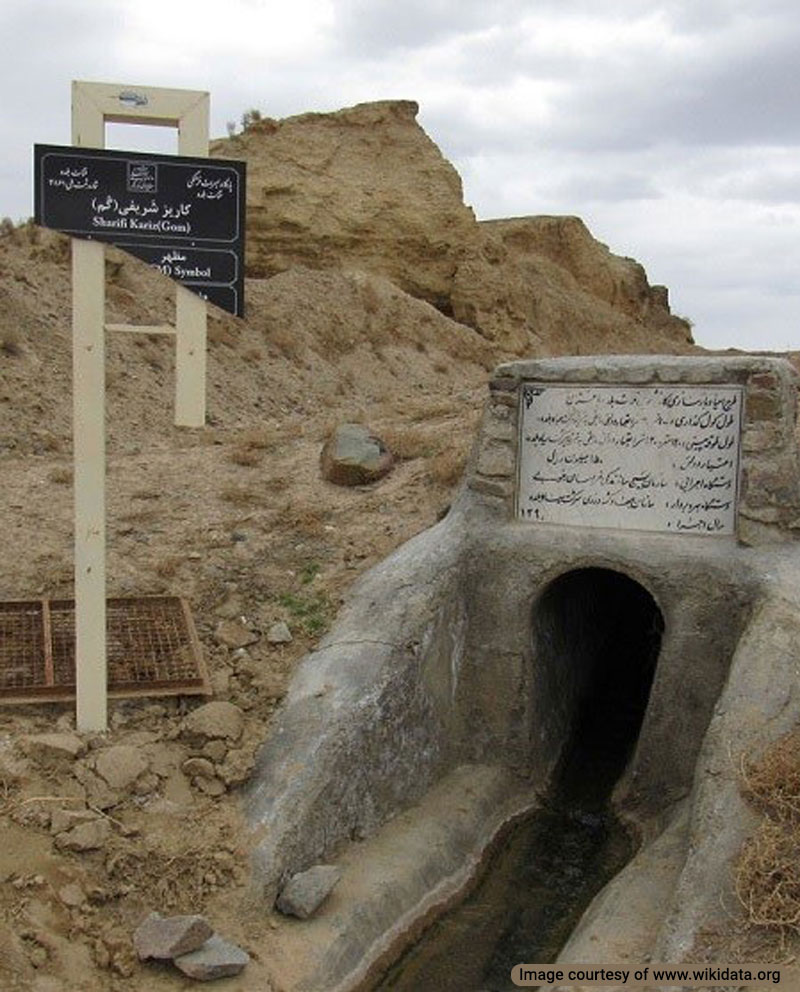
- Location: Ferdows, South Khorasan Province, Iran
- History: Dates back to the Sasanian period.
- Structure: Comprises 15 branches with a total length of 19 kilometers and 440 well shafts.
- Function: Supplies water for agricultural and potable use, irrigating over 2,081 hectares.
- UNESCO Status: Inscribed as a UNESCO World Heritage Site in 2016.
Zarch Qanat in Yazd
The oldest active Qanat in the world is called the Zarch Qanat which is over 3,000 years old. This aqueduct starts from Fahraj village and reaches Yazd through a 60-kilometer route, and after Yazd, it enters the Zarch region. Zarch aqueduct has three branches named Shirin, Shur and Ibrahim Khoydaki. Of course, currently, only the Shur branch is active and the other two branches are dry.
This aqueduct has about 2,000 access shafts, a few of which are located in the Jameh Mosque of Yazd. Since the aqueducts were built long before the arrival of Islam in Iran, it can be said that due to the importance of the water supply, the mosque was placed near the aqueduct access shafts. The wells were also used to fill the mosque’s water so that the worshipers had enough water for Wudu (ablution).
Until about 50 years ago, the water flow of the Zarch aqueduct was more than 180 liters per second, which has decreased significantly today. The Zarch Qanat is considered a national heritage that has been registered by UNESCO.
- Location: Yazd, Yazd Province, Iran
- History: Originates from the Sassanian period, over 1,000 years old.
- Structure: One of the longest qanats in Iran, stretching over 71 kilometers.
- Function: Supplies water to the city of Yazd and its surrounding areas, supporting local agriculture.
- UNESCO Status: Inscribed as a UNESCO World Heritage Site in 2016.
Hassan Abad Moshir Qanat
- Location: Yazd, Yazd Province, Iran
- History: Constructed during the Safavid period.
- Structure: Known for its intricate underground channels and reliable water flow.
- Function: Supplies water for agricultural and domestic use in Yazd.
- UNESCO Status: Inscribed as a UNESCO World Heritage Site in 2016.
Gohar Riz Qanat
- Location: Kerman, Kerman Province, Iran
- History: Dates back to the Qajar period.
- Structure: Features a complex network of underground tunnels.
- Function: Provides water for agricultural and domestic use in Kerman.
- UNESCO Status: Inscribed as a UNESCO World Heritage Site in 2016.
Akbar Abad Qanat
- Location: Yazd, Yazd Province, Iran
- History: Constructed during the Safavid period.
- Structure: Features well-preserved underground channels.
- Function: Supplies water for agricultural use in Yazd.
- UNESCO Status: Inscribed as a UNESCO World Heritage Site in 2016.
Ghasem Abad Qanat
- Location: Kerman, Kerman Province, Iran
- History: Built during the Qajar period.
- Structure: Includes a well-maintained system of underground channels.
- Function: Provides water for agricultural and domestic use in Kerman.
- UNESCO Status: Inscribed as a UNESCO World Heritage Site in 2016.
Moun Qanat
- Location: Isfahan Province, Iran
- History: Dates back to the Safavid period.
- Structure: Known for its intricate design and water management system.
- Function: Supplies water for agricultural use in Isfahan.
- UNESCO Status: Inscribed as a UNESCO World Heritage Site in 2016.
Vazvan Qanat
- Location: Isfahan Province, Iran
- History: Constructed during the Safavid period.
- Structure: Features well-preserved underground channels.
- Function: Supplies water for agricultural and domestic use in Isfahan.
- UNESCO Status: Inscribed as a UNESCO World Heritage Site in 2016.
Mozd Abad Qanat
- Location: Isfahan Province, Iran
- History: Built during the Safavid period.
- Structure: Known for its efficient water distribution system.
- Function: Provides water for agricultural use in Isfahan.
- UNESCO Status: Inscribed as a UNESCO World Heritage Site in 2016.
Ebrahimabad Qanat
- Location: Markazi Province, Iran
- History: Originates from the early Islamic period.
- Structure: Features a well-engineered network of underground tunnels.
- Function: Supplies water for agricultural and domestic use in Markazi Province.
- UNESCO Status
Different Parts of the Persian Qanat
The Persian Qanat consists of several wells or vertical shafts on a sloping surface. Under these access shafts, there is a corridor called a waterway or groundwater reserve. In the following, we introduce the main parts of a Qanat:
- Channel: A channel or aqueduct tunnel is a horizontal channel that is dug to access the underground water reserve and its height is about 90 to 150 cm so that the aqueduct diggers can move around easily.
- Mazhar-e Qanat (Qanat Outlet): where the Qanat water leads, and it is the place where the Qanat channel is level with the sloping ground.
- Mileh Chah (Access Shaft): The access shafts are dug in the path of the aqueduct channel and their main use is to remove the excess soil from digging the channel and create proper ventilation in the path of the aqueduct. The access shafts are also used for dredging and necessary repairs along the Qanat channel. The diameter of the shafts is between 80 and 100 cm, and depending on the location of the aqueduct, the distance between them is 20 to 200 meters.
- Mother Well: It is the first well that is dug on the Qanat channel and the furthest well from the outlet. The mother well is dug deeper than the rest of the wells, and several blocked wells are dug in it in different directions to obtain more water flow in the aquifer.
- Khoshek Kar (Dry areas): parts of the aqueduct where water has not yet flowed after digging.
- Tareh Kar (Wet areas): The part of the aqueduct in which water flows.
Technical Features of the Persian Qanat
The Qanat architecture showcases the ingenuity of traditional Iranian architecture, as it displays cunning adaptability and use of natural resources. Let’s go over the main technical features that distinguish Persian Qanat from other ancient aqueduct systems:
Gravity-Based Water Transport
Natural Flow: Qanats harness the natural slope of the land, utilizing gravity to transport water from underground aquifers to the surface. This method eliminates the need for mechanical pumps, ensuring a continuous and energy-efficient flow of water.
Slope Calculations: Engineers carefully calculated the gradient of the qanat tunnel to maintain a gentle slope, allowing water to flow steadily over long distances without causing erosion or stagnation.
Elevation Management: By carefully managing the elevation from the aquifer to the surface outlet, qanats ensure that water reaches its destination with sufficient pressure and volume.
Vertical Shafts for Maintenance
Ventilation: The vertical shafts, known as mothers and sons in local terminology, serve as air vents that maintain airflow within the qanat tunnel, preventing the buildup of harmful gases and facilitating ventilation.
Access Points: These shafts provide access points for workers to enter the qanat for regular maintenance, cleaning, and repairs. This ensures the long-term functionality and efficiency of the qanat.
Debris Removal: Vertical shafts allow for the removal of silt, sediment, and other debris that may accumulate within the tunnel, ensuring unobstructed water flow.
Air Cooling System
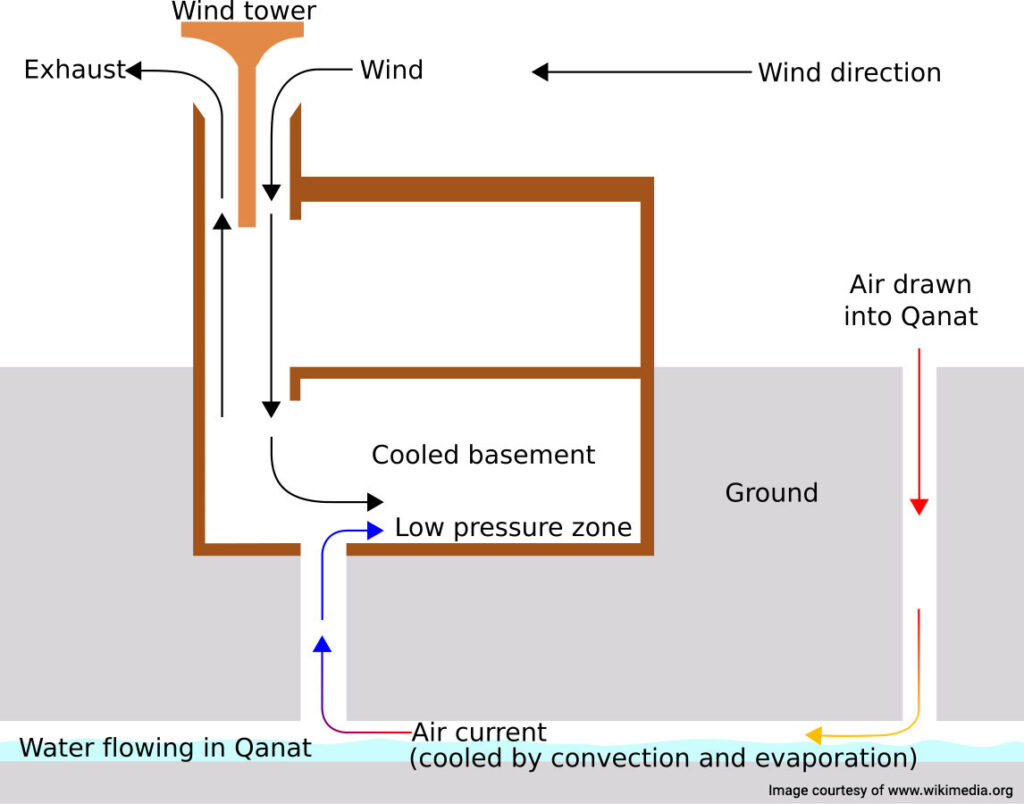
The Qanat, together with the windcatcher, were used as airconditioning systems in desert regions. The underground cool weather would circulate in the lower areas and supplement the windcatcher system to drastically lower temperatures in the house. The cellars that were cooled by the Qanat were used to store food in the summer and cool down the temperature of fruit such as watermelon with running cold water.
Sustainable Water Supply
Minimal Evaporation: The underground nature of qanats protects the water from direct sunlight, significantly reducing evaporation and preserving precious water resources in arid and semi-arid regions.
Consistent Flow: Qanats provide a consistent and reliable water supply year-round, even during dry seasons, making them a crucial infrastructure for communities in arid regions.
Environmentally Friendly: By avoiding the use of mechanical pumps and relying on gravity, qanats are an environmentally sustainable method of water management.
Resilience to Natural Disasters
Flood Resistance: The underground construction of qanats makes them highly resistant to flooding, which can otherwise disrupt surface water channels and irrigation systems.
Earthquake Tolerance: The flexible and decentralized structure of qanats allows them to withstand seismic activity better than rigid, modern water infrastructure.
Climate Adaptability: Qanats can adapt to changing climate conditions, providing a stable water source even in times of environmental stress.
Construction: Preparations, Excavation and Maintenance
The construction and maintenance of qanats require a combination of traditional knowledge, meticulous planning, and community cooperation. These ancient systems continue to be a vital part of Iran’s heritage, demonstrating remarkable engineering skills and sustainable water management practices.
Site Survey and Selection
Geological Survey: Before construction, a detailed geological survey is conducted to identify suitable locations with accessible groundwater. This involves studying rock formations, soil types, and aquifer locations. Local knowledge and historical data about existing water sources and successful qanats in the region were considered to choose the best site.
Slope and Elevation: The natural slope of the land is crucial. Engineers calculate the gradient needed to ensure gravity will effectively transport water from the aquifer to the surface.
Planning and Design
Planning included the allocation of necessary resources such as labor, tools, and materials. Adequate manpower is crucial for the timely completion of the project. The local community was engaged in the planning process, ensuring they understood the importance of the qanat and were ready to participate in its construction and maintenance. Arrangements were made about turn-based access to the water for farm irrigation.
Excavation
Digging Vertical Shafts
Initial Shaft: The construction starts with the digging of an initial vertical shaft at the water source (mother well). This shaft is used to determine the depth and quality of the groundwater.
Spacing and Depth: Vertical shafts are dug at regular intervals along the planned route of the qanat. The spacing and depth of these shafts vary based on geological conditions, typically ranging from 20 to 35 meters apart and 20 to 200 meters in depth.
Manual Labor: Traditionally, digging was done manually using hand tools such as picks and shovels. Teams of diggers worked in shifts to excavate the shafts efficiently.
Tunneling
Connecting Shafts: Once vertical shafts were in place, workers began tunneling horizontally to connect these shafts, forming the qanat tunnel. The tunnel was designed with a gentle slope to allow water to flow by gravity.
Excavation Techniques: Specialized techniques were used to ensure the tunnel remained stable and to prevent collapses. Wooden beams or stone linings were used to reinforce the tunnel walls. Excavated soil and rock are removed through the vertical shafts using buckets or other manual methods. This debris is typically piled around the shaft openings.
Maintenance
Regular inspections were scheduled to monitor the condition of the Qanat. This included checking for blockages, collapses, and water flow efficiency. Community members were often responsible for the ongoing maintenance, ensuring the qanat continued to function effectively.
Cleaning and Repair
Periodic cleaning was necessary to remove silt and debris that accumulated in the tunnel, which could obstruct water flow. Workers entered through the vertical access shafts to perform these tasks. Any structural damage to the tunnel or shafts is promptly repaired. This may involve reinforcing walls, replacing collapsed sections, or installing additional support beams.
Pest Control: Measures are taken to prevent and address infestations by animals that may burrow into the qanat and cause structural damage.
Water Management
Water flow was monitored to ensure the optimal balance between supply and demand. This included adjusting the opening and closing of sluices or gates within the qanat system. Water usage was planned and monitored to prevent over-extraction, ensuring the sustainability of the water source for future generations.
Qanat Applications
Qanats have been integral to the survival and prosperity of communities in arid regions, serving multiple purposes beyond mere water supply. They exemplify the ingenuity and adaptability of ancient engineering practices, making significant contributions to agriculture, daily life, industry, ecology, and cultural heritage.
Irrigation
Agricultural Sustainability: Qanats provide a consistent and reliable source of water for irrigation, enabling the cultivation of crops in arid and semi-arid regions. This helps to sustain agriculture throughout the year, ensuring food security.
Crop Diversification: The reliable water supply allows farmers to grow a variety of crops, including water-intensive ones, which would not be possible with rain-fed agriculture alone.
Drinking Water
Clean Water Supply: Qanats provide a source of clean and potable water, which is essential for drinking and daily household use. The natural filtration through the underground channels helps to ensure the purity of the water. Villages and towns relied on qanats for their drinking water supply, especially in regions where surface water is scarce or unreliable.
Health Benefits: Access to clean drinking water from qanats has historically contributed to improved public health and sanitation in many communities.
Industrial Use
Traditional Industries: Qanats have historically supported various traditional industries, such as textile production, pottery making, and leather tanning, by providing a steady water supply for their operations.
Modern Adaptations: In some areas, qanats continue to support small-scale modern industries that require water, such as food processing and handicrafts.
Economic Contribution: The availability of water for industrial use has contributed to the economic development and sustainability of local communities.
Ecological Balance
Supporting Vegetation: Qanats create green oases in otherwise arid landscapes, supporting the growth of vegetation and maintaining biodiversity. These green areas can help to stabilize the soil and prevent desertification.
Wildlife Habitat: The presence of water from qanats creates habitats for various wildlife species, contributing to the ecological balance of the region.
Ancient Methods of Digging the Persian Qanat
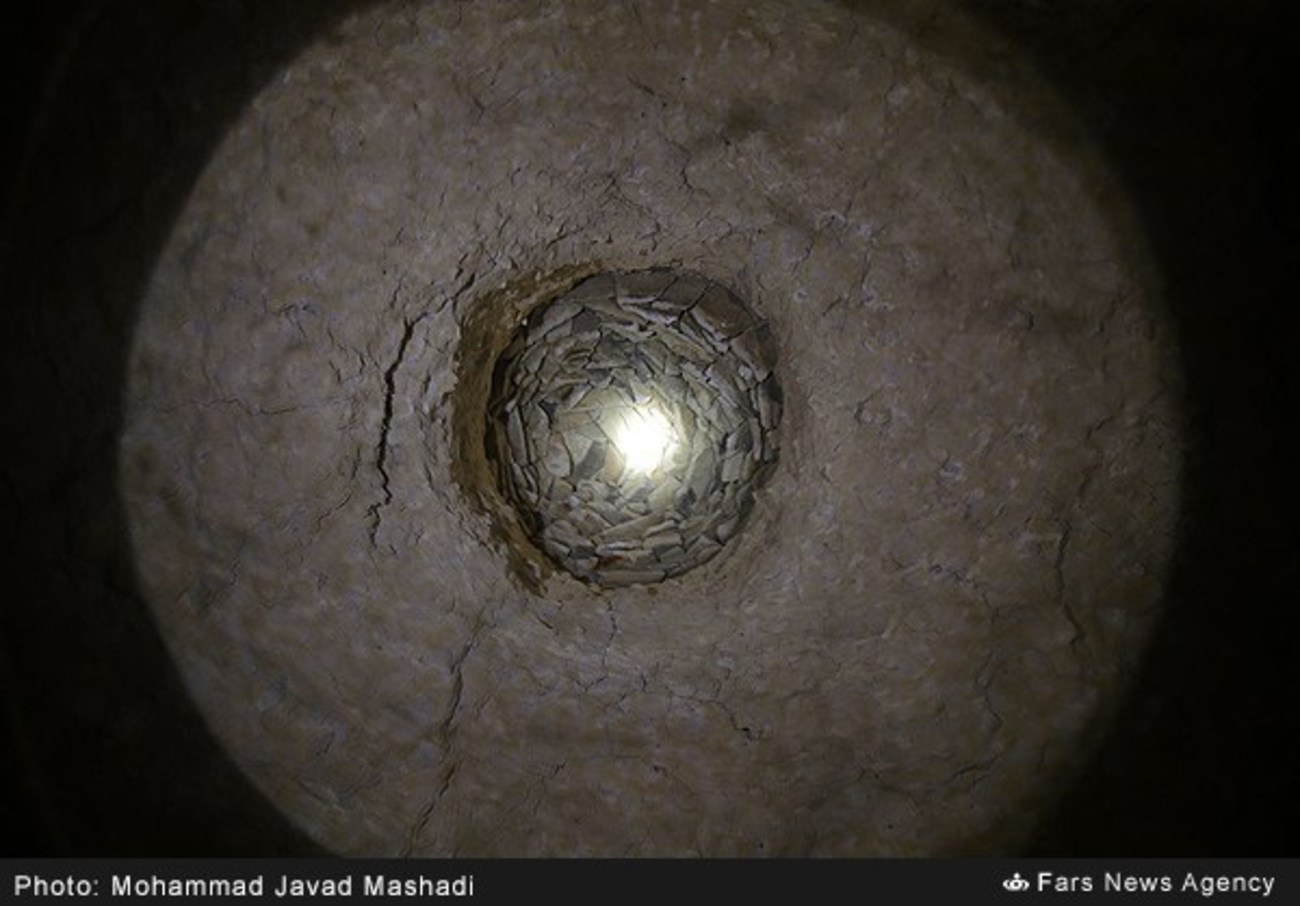
By inventing the Qanat system, our ancestors were able to bring life to areas where it seemed impossible. We owe the start and continuation of life throughout many modern Iranian cities to this invention and their efforts in digging Persian Qanats.
The first step for the construction of any Qanat is to dig a borehole, which is done to test the presence of groundwater resources and determine the depth of the reserve. When the borehole is drilled and if water is found, they must determine whether the well will maintain a steady flow of water in an impermeable layer. If the answer is yes, the leveling and sloping of the aqueduct is the next step. Then the borehole is transformed into a mother well.
The waterway should not be too steep. Because in this case, the water flows at a high speed and causes the erosion of the Qanat channel walls, and as a result, the channel collapses. The work of digging the aqueduct usually starts from the Qanat outlet, That is, from where the water reaches the surface of the earth. Using shovels and picks, they dig a tunnel from the outlet towards the mother well. Sometimes, they start building the aqueduct channel from both sides at the same time.
Vertical access shafts are usually dug 20-35 meters apart from the ground surface to lead to the channel. Sometimes they dig the access shafts first and finally connect the wells by digging the channel. A mud or stone coating in the upper part of the wells makes them more reliable.
The excavated soil is transported to the surface of the earth with the help of a windlass using a bucket. If the well is too deep, they install another windlass in the middle of the shaft in a suitable place. Usually, a ring of soil accumulates on the ground around the well. If you look at the aqueduct from the sky, you will see a series of wells that look like a line with small openings.
The slope of the aqueduct is determined by using a hanging level between two ropes, each of which is 9 meters long. The slope of short aqueducts varies: from a slope decrease of 1 meter for every 1000 meters of length to a slope decrease of 1 meter for every 1500 meters of length. But the slope of long aqueducts is almost zero on a smaller scale.
When needed, they dig the aqueduct with a steeper slope. For this purpose, they usually destroy the routing line at one point and let the water reach a level lower than its original level and closer to the water table. Therefore, an underground waterfall is created. Realizing the flow of water in such places, people build water mills to use water for other purposes such as grinding grains.
Examples of the Persian Qanat in Iran
In the following, you can see pictures of Qanats from different areas in Iran and masterpiece examples of this Iranian architectural invention:
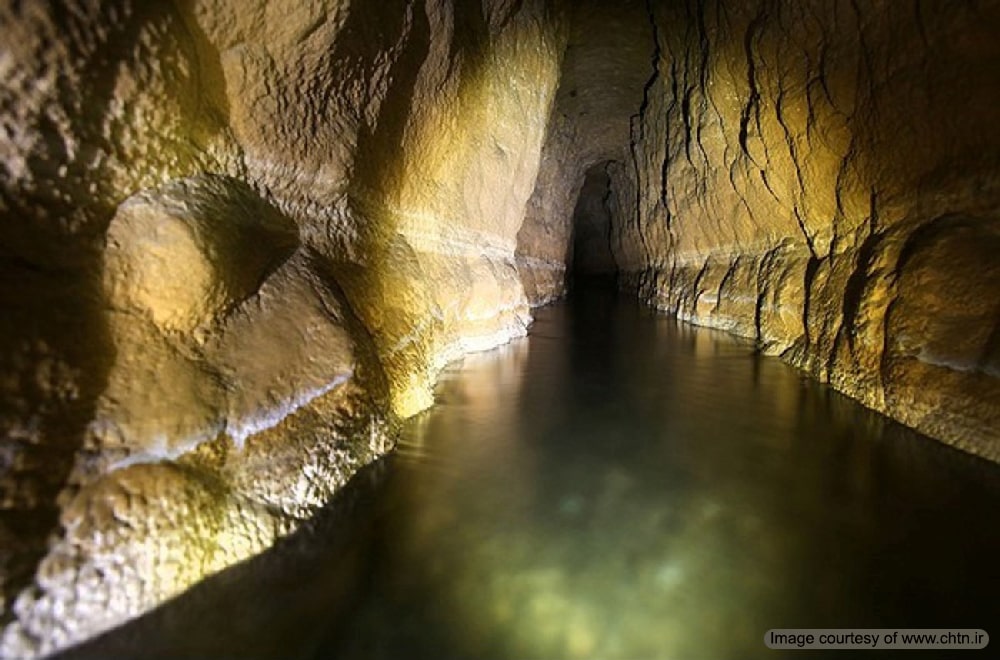
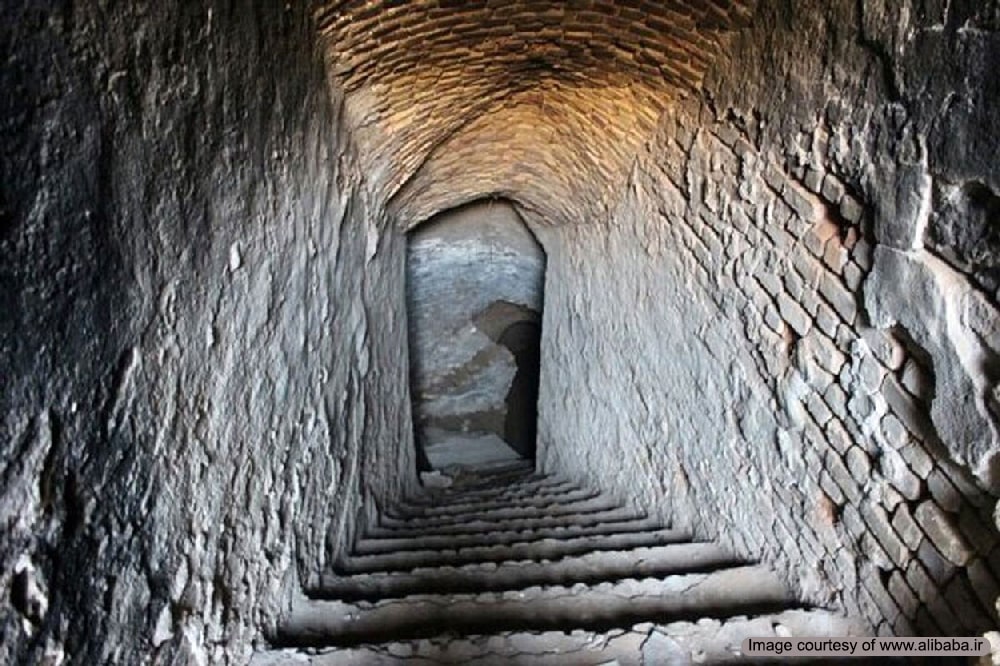
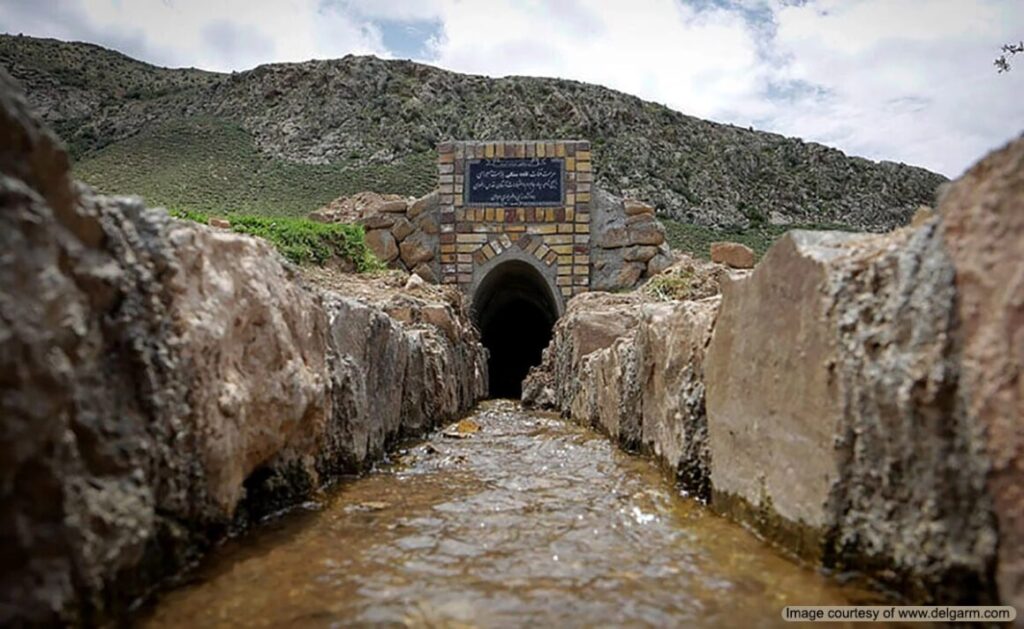
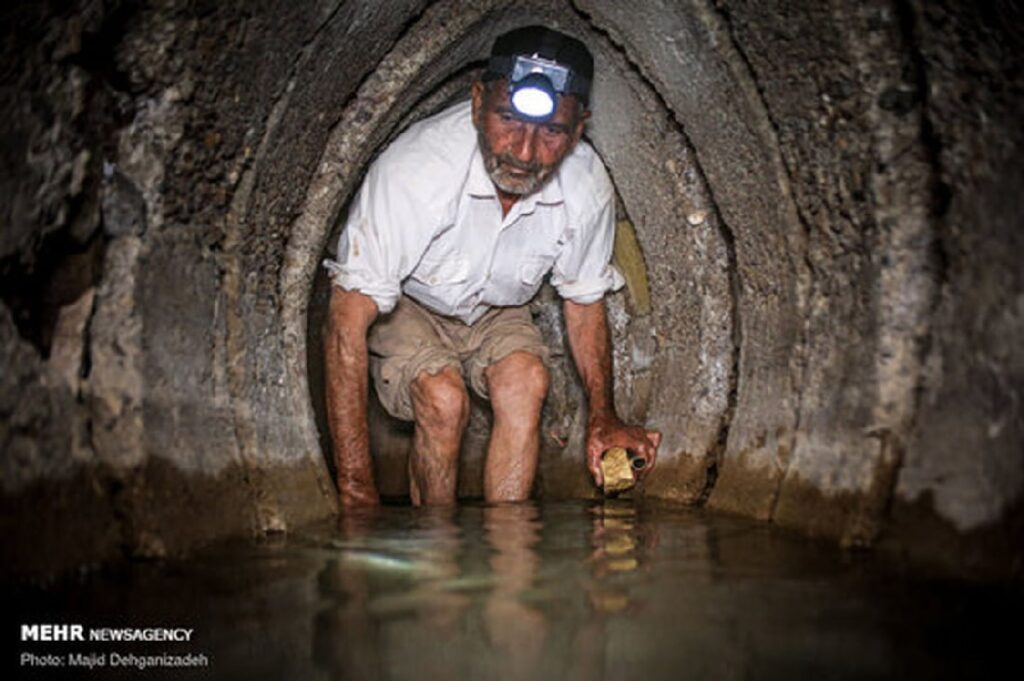
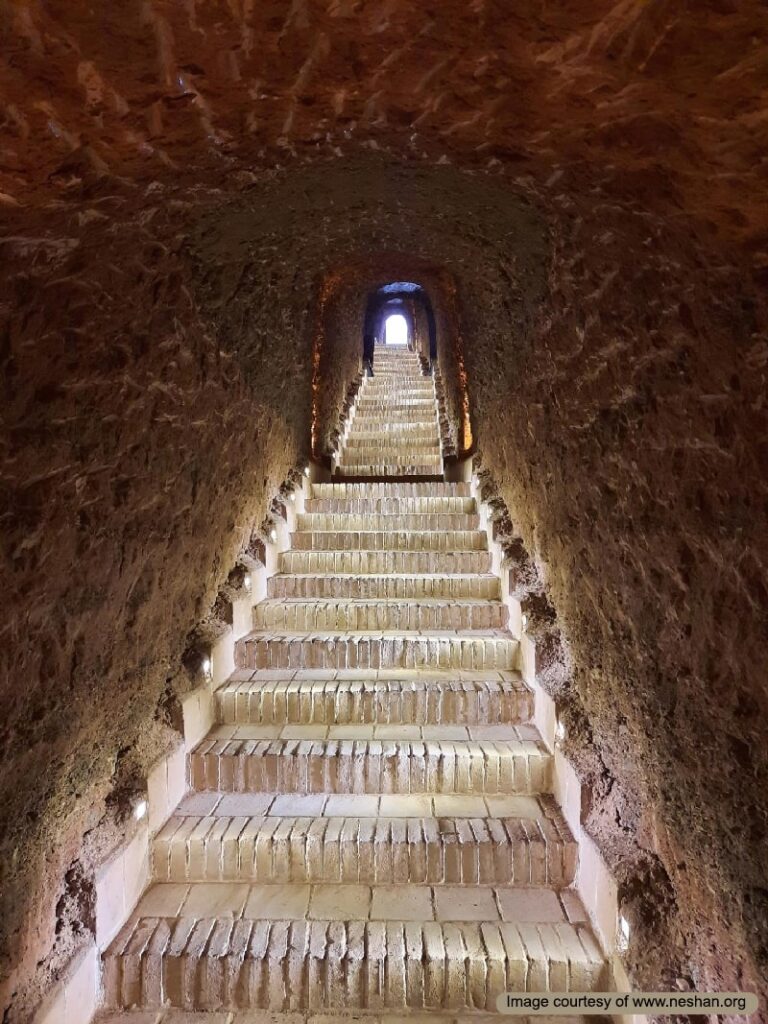
Advantages of the Qanat System
Qanats are a sustainable method of water transportation that evolved in the desert regions. Aqueducts offer a wide range of advantages in arid and semi-arid areas.
- Transportation of water over long distances
In arid and semi-arid regions, water is the most valuable resource. But before the invention of motorized vehicles, long-range transportation with caravans would prove difficult. The development of aqueducts created a method to bring water to areas in the middle of the desert. There is no discernable evaporation of water in the aqueducts throughout the canals. This allowed for an expansion of civilization into desert areas, without which the establishment of some cities or creating farmlands in areas such as Yazd would have been impossible.
- Sustainability and durability
Qanats were relatively easy to maintain and did not require constant supervision. In addition, repairing the canals did not require significant manpower. In addition, Qanats were resistant to floods, earthquakes, sunlight, and storms. They could not be easily destroyed during wars, and could even be used to circumvent an invading army.
- Easy expansion and modification
Qanats can be easily expanded to cover new areas and irrigate new lands or maneuver around areas where the original aqueduct had collapsed. New canals can be added to extend the original aqueduct to create an oasis in the middle of the desert. In addition, if anything happened to the original water source, a new path could be dug to access a newly discovered underground water reserve.
- Use of gravity, eliminating the need for manual extraction
Unlike water wells which require manpower to extract water from the underground, the Qanat system uses gravity and creates a slope to transport the water. The entire system operates without the need for any external force to extract the water, meaning everyone can access it by walking down the stairs that lead to the channel.
- Powering water mills
The constant flow of water in the aqueduct was often utilized to power water mills, which were used to grind flour or extract seed oils. There are many examples of water mills in historical aqueducts, such as the Kuskh-e No water mill in Yazd which was constructed over the conjunction of three Qanats.
Disadvantages of the Qanat System
Although digging an aqueduct is a cheap and convenient way to provide water; It also has disadvantages:
- It is not possible to dig an aqueduct in lands that are flat and do not have a suitable slope, or whose soil is sandy and unstable
- Aqueducts are more vulnerable to floods and earthquakes than wells
- If the aqueduct is damaged, it may not be cost-effective to repair and rebuild it
- Aqueducts access shallow underground water tables and these resources shrink in the hot season of the year when crops need more irrigation, but the aqueduct may be dry or low on water.
Water Flow Rate of Persian Qanats
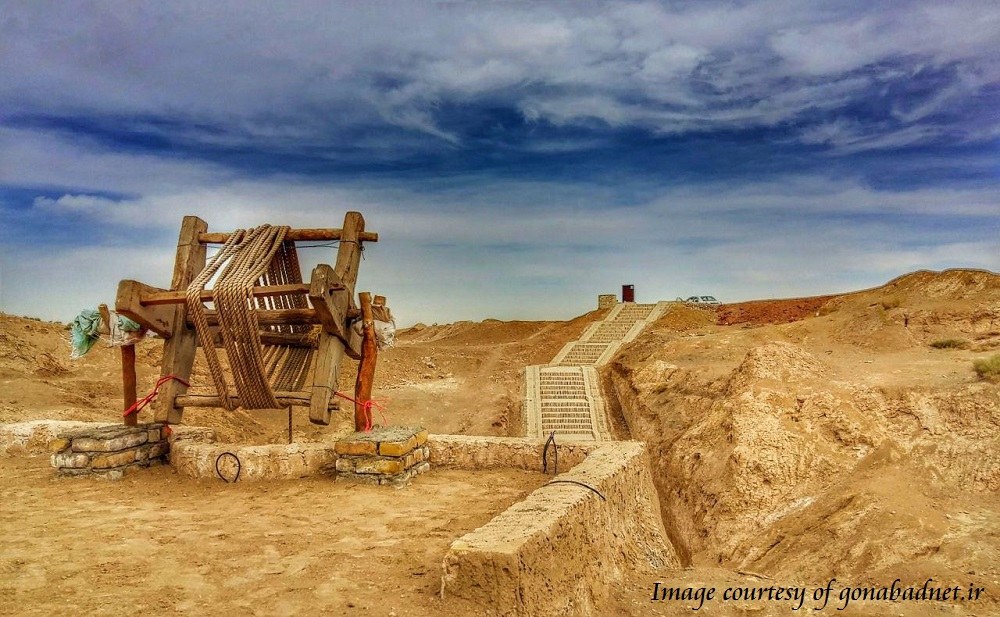
It should be noted that the water level of the aqueduct depends on various factors:
- Soil type
- The amount of groundwater exploitation in the region
- Oscillation of water table level
- The length and size of the aqueduct structure
- Aqueduct dredging
Aqueducts built on permanent water tables usually have constant water flow throughout the year. But when an aqueduct is located on an unstable or seasonal groundwater source or with permeable soil, its flow may be greatly reduced or run dry in summer or dry years. Therefore, the location of the aqueduct and its water supply table are important.
The water flow of some aqueducts reaches 1750 liters per minute, but most of the Persian Qanat systems have far less water flow, typically about 15 liters per minute.
Maintenance of the Qanat System
Each Qanat can access water for hundreds of years. Its wells also last between 20 and 50 years, of course, extended use depends on their timely restoration and proper care.
Aqueduct digging paths should be regularly dredged and repaired. Aqueducts are prone to collapse or damage due to sudden floods. To prevent the wells from being filled with soil, their openings are covered with stone slabs or other materials.
The people who are involved in digging the Qanat and maintaining this system are called Moqqani. They endure extreme work conditions in fulfilling such hard labor.
To check the ventilation of the underground channel, the Moqqani use castor oil lamps. If there isn’t enough oxygen to keep the flame burning, another well is dug. They clean mineral deposits from the bottom of the waterway. Any kind of damage to the well cannot be repaired without the help of these experts. This means users cannot access water until the aqueduct or water supply facilities are repaired.
These damages include the collapse of the roof of the waterway or the walls of the wells, the accumulation of sediments such as sand or mud in the underground channel, the blockage of the waterways, etc. It should be mentioned that the Moqqani in Yazd have always been famous for their professional skills in digging and maintaining the aqueduct.
Ownership and Water Distribution in Qanat Systems
Usually, there are several owners of the land where the Qanat is dug. As a result, Qanat water rights are bought and sold. Some landowners endow the Qanat on their land (partially and sometimes completely) to the community in which they live.
The distribution of Qanat water is determined by an agreement between its users or their representatives, divided into specific time intervals. If the irrigation levels of the aqueduct are desirable and significant and its users are numerous, the distribution is under the supervision of a trusted and known person, who is called “Mirab”. Mirab is someone who is chosen by the government or the Qanat stakeholders to monitor the fair distribution of water and is paid a certain salary.
The Importance of the Persian Qanat System
Without the digging of ancient aqueducts, many human settlements would never exist. Also, there were no large oases that later turned into small or big cities like Qazvin, Neyshabur, Kerman, Yazd, etc. As a result, there would be no farmlands in the mentioned areas.
Since ancient times, there have been rules on how to fairly distribute water between the various small and large villages along the Qanat channel. These rules were established to prevent any disagreement leading to disagreement, conflict, or disorder.
Even today, Persian Qanats are still important in some areas and remain the only source of residential water supply and irrigation. However, in densely populated areas, the Qanat has lost its effectiveness as the main source of water supply.
Finally, digging a Persian Qanat has been an essential and integral part of the life of ancient Iranians. It played an important role in the formation of many aspects of Iranian culture.
Impact of the Persian Qanat on settlement patterns
Overall, the Persian Qanat has profoundly impacted the settlement patterns, economic development, and social structures of communities in Iran. They enabled the flourishing of civilizations in harsh climates by providing a reliable and sustainable water source. The legacy of qanats continues to be evident in the layout and prosperity of many Iranian towns and cities today.
Urban Development
Foundation for Cities: Qanats played a crucial role in the establishment and growth of many ancient and modern cities in Iran. The reliable water supply provided by qanats allowed for the development of urban centers in otherwise arid and inhospitable regions.
Infrastructure Planning: The presence of qanats influenced the layout and planning of cities. Streets, neighborhoods, and agricultural fields were often aligned with the paths of qanat tunnels to maximize access to water.
Agricultural Expansion
Increased Arable Land: By providing a steady supply of water, qanats enabled the cultivation of crops in areas that would otherwise be unsuitable for agriculture. This led to the expansion of farmlands and increased food production.
Sustainable Farming: Qanats supported sustainable agricultural practices by ensuring a consistent water source, which allowed for crop rotation and reduced the risk of soil degradation.
Population Distribution
Water-Dependent Settlements: Villages and towns often sprung up along the routes of qanats. The availability of water determined where people could live and work, leading to clusters of settlements around Qanat exits.
Desert Habitation: Qanats made it possible to inhabit desert regions by providing the necessary water for drinking, irrigation, and livestock. This expanded human habitation into previously uninhabitable areas.
Economic Growth
Boost to Local Economy: The consistent water supply from qanats supported various economic activities such as agriculture, trade, and craftsmanship. This economic stability attracted more settlers and contributed to the growth of local markets.
Trade Routes: Some qanat systems were strategically placed along major trade routes, providing water for traders and travelers. This helped establish and maintain important trading hubs.
Frequently Asked Questions About the Persian Qanat
If you did not find the answer to your question here, leave us a comment in the comment section below this post and ask your question. We will answer it as soon as possible.
What is the Persian Qanat or Kariz?
In the old days, the aqueduct system known as Qanat or Kariz was used to supply water to residential areas. Aqueducts were dug underground and brought water from higher altitude areas with rainfall to lower arid areas (such as deserts).
How old is the Persian Qanat?
Digging an aqueduct for water supply in Iran can be traced back about 5 thousand years.
How does the Qanat work?
After finding a point for drilling the mother well, a series of vertical shafts with a certain slope are dug towards the target residential area. These wells are connected by channels in the underground and transfer water to the desired location. It is interesting to note that the water flows smoothly and reaches its destination without any device due to the gentle slope created by the Moqqani in these underground channels.
What is the difference between a Qanat and a well?
An aqueduct is a set of wells and channels dug underground to transport water from a water table. A well is a cylindrical pit that is dug vertically to reach groundwater reserves. Other differences between a well and an aqueduct include the following:
- The type of percussive drilling in digging a well is only vertical; But in the Qanat, excavations are done in both vertical and horizontal paths
- Potential sites for well digging are different from the aqueduct
- To dig an aqueduct, a professional Moqqani is needed, while a well can be dug with a machine.
What is the name of the oldest Qanat in Iran?
Zavareh Qanat is the oldest aqueduct in Iran, which is 5,000 years old.
What are the two types of aqueducts based on their length?
Aqueducts are divided into two categories in terms of length: “long aqueducts” and “short aqueducts”. Annual precipitation has a significant effect on the length of the aqueducts. The more rainfall there is in a region, the shorter the aqueducts.
What are the types of Qanat based on their depth?
Aqueducts have different depths. According to their depth, the aqueducts are divided into two categories: “deep aqueducts” and “surface aqueducts”. The depth of deep aqueducts sometimes reaches 100 meters.
What are the types of Qanat based on their water flow rate?
Aqueducts are divided into two categories according to the amount of water:
- Aqueducts that have water throughout the year and their water flow is constant.
- Aqueducts whose water flow depends on the annual rainfall.
What is a Qanat-e Bayer (dry aqueduct)?
Bayer means barren, Qanat-e Bayer is a dry aqueduct that does not have enough water for irrigation and cannot be used.
How is the Qanat registration done in Iran?
There are two ways to register the Qanat:
- The first case is when the owner is one person. In this case, the full rights of the Qanat will be granted to the individual’s name after going through legal procedures.
- The second case is for when the aqueduct belongs to more than one person. In this case, based on the time interval of water access, the amount of each person’s share is determined and registered in their name.
Qanats are registered in a special notary office, the Qanawat Registration Office, which depending on the number of aqueducts and the size of the city, may need to be registered in the offices of different areas of the city.
Source: qavanin.ir
How vast are the bounds of a Qanat?
According to the law, the boundary of the aqueduct is 500 Gaz on soft ground and 250 Gaz on hard ground (Gaz is a measurement unit, about 106 cm). Of course, the bounds can be increased after legal consideration and to prevent losses.
How many meters is the aqueduct limit for construction?
According to the law, the construction near the aqueduct bounds must be at least 6 meters apart.






